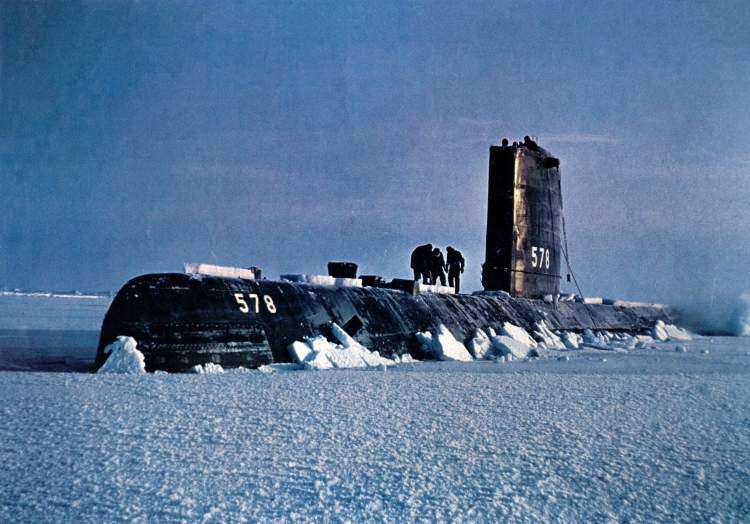The quest to conquer the North Pole has captivated explorers throughout history, and in the 20th century, two pioneering submarines, the USS Nautilus and the USS Skate, pushed the boundaries of human achievement by venturing into the treacherous waters of the Arctic Ocean.

These groundbreaking expeditions represented significant milestones in both military capabilities and scientific exploration.
USS Nautilus
The story begins with the USS Nautilus. This vessel conducted its own groundbreaking journey to the North Pole just a week before the USS Skate.
The USS Nautilus was commissioned in 1954 and was the United States first ever nuclear powered submarine.
She represented a significant leap forward in submarine technology. Its construction and revolutionary nuclear propulsion system revolutionized naval capabilities and paved the way for unparalleled achievements in underwater exploration.
The Nautilus was constructed at the Electric Boat Division of General Dynamics Corporation in Groton, Connecticut, under the guidance of Admiral Hyman G. Rickover, a visionary naval officer who played a crucial role in developing nuclear-powered vessels.

Operation Sunshine
Operation Sunshine, the Nautilus’ mission to the North Pole, was conceived as a strategic and symbolic endeavor for the United States.
The voyage aimed to showcase the country’s technological prowess, bolster national security interests, and expand scientific knowledge of the Arctic region.
Setting sail from Pearl Harbor, Hawaii, on July 23, 1958, the Nautilus embarked on its journey to the North Pole.
The submarine made its way through the Bering Strait, the narrow waterway separating Alaska and Russia, and entered the Arctic Ocean.
As the Nautilus ventured further north, it encountered the formidable challenges posed by the Arctic environment.
The submarine had to navigate through shifting ice formations, endure extreme cold temperatures, and constantly monitor the thickness and stability of the ice to ensure the safety of the vessel.
 USS Skate in the arctic circle.
USS Skate in the arctic circle.
Operation Sunshine presented an opportunity for extensive scientific research and data collection.
The Nautilus was equipped with advanced sonar systems and other scientific instruments to gather information about the Arctic environment.
The crew conducted measurements of water temperature, salinity, and other oceanographic parameters.
They also collected valuable data on the ice cover, studying its thickness and variations.
After weeks of navigating through the harsh Arctic waters and travelling nearly 1,000 miles underwater, the USS Nautilus achieved a historic milestone.
On August 3, 1958 – the first ever operational nuclear powered submarine also became the first ever submarine to reach the North Pole.
However, the Nautilus would not surface at Pole.
USS Skate
Construction of the USS Skate began on April 21, 1955, and the submarine was launched on December 2, 1957. Like the Nautilus before her, the Skate was also built by General Dynamics Corporation in Groton, Connecticut.
She was commissioned into the United States Navy on December 23, 1957, becoming the third nuclear powered submarine to be commissioned into the Navy.
 USS Skate in Rotterdam, 1958.
USS Skate in Rotterdam, 1958.
Within a week of the Nautilus setting sail from Pearl Harbor on its historic voyage to the North Pole, the USS Skate also undertook its own expedition to the Pole. However, the objectives of the Skate differed from that of the Nautilus.
The Skate aimed to achieve the distinction of being the first submarine to surface at the North Pole.
On August 11th, the Skate reached its destination. However, the perilous icy conditions prevailing at the time posed a significant risk to the vessel, preventing it from surfacing at the precise location as planned.
The Second Journey
In early 1959, the USS Skate was poised once again for the North Pole. She followed the same course as her last journey – through the Bering straight and into the Arctic.
This time, the vessel travelled over 2,000 miles under water.
The USS Skate reached the North Pole for the second time on 17 March, 1959. This time, the vessel was able to break through the ice and surface. It is worth noting that this time of the year is when polar conditions are particularly cold and the ice extremely thick.
 USS Skate surfaced in the Arctic.
USS Skate surfaced in the Arctic.
The crew planted an American flag and ceremonially spread the ashes of the Australian Polar Explorer Sir George Hubert Wilkins.
USS Skate After The Expedition
When the Skate returned to port, she was awarded with the Bronze star for demonstrating ‘… for the first time the ability of submarines to operate in and under the Arctic ice in the dead of winter…’.
The vessel took part in submarine defense exercises in 1959 and 1960 and then returned to General Dynamics for an overhaul.
In 1962, the Skate headed to the North Pole again. This time, she would rendezvous with the submarine USS Seadragon, where they would both surface at the North Pole on 31 July 1962.
 USS Skate and USS Seadragon after surfacing in the Arctic.
USS Skate and USS Seadragon after surfacing in the Arctic.
What Happened to The USS Skate?
The USS Skate may no longer be sailing the seas, but its legacy still lives on. This submarine served with distinction during its active years, earning numerous accolades and commendations along the way.
But like all ships, USS Skate also reached the end of its operational lifespan. USS Skate decommissioned on September 12 in 1986.
After being decommissioned, it was stricken from the Naval Vessel Register on October 30, 1986, and eventually recycled at the Puget Sound Naval Shipyard on March 6th, 1995
Conclusion
The journeys of the USS Nautilus and the USS Skate to the North Pole were monumental achievements in human exploration and scientific progress.
These pioneering submarines demonstrated the indomitable spirit of human curiosity, pushing the boundaries of what was deemed possible.
News
Miley Cyrus N-de & S*xy Collection (10 Photos)
Miley Cyrus, the American Fappening celeb, is in a new set of nude and sexy pics, showin’ off her stuff! Instagram: https://www.instagram.com/mileycyrus/
Exactly 6 years ago, Taylor Swift’s “MV that made the audience talk a lot” Delicate was released globally.
After exactly 1 year and 4 months of release, Taylor Swift’s “Look What You Make Me Do” has officially reached 1 billion views on YouTube. On December…
Sylvester Stallone’s model daughter Sistine, 17, looks just like her mother Jennifer Flavin, 46, as they step out in matching denim shorts in Antibes
Sylvester Stallone is currently soaking up the sun in Antibes, France, with his stunning wife and daughters and the family resemblance is clear to see. The Rocky…
Miley Cyrus’ Fans Speculate That She Got ‘Plastic Surgery’ After Seeing Before-And-After Photos From 2012 To 2024
Miley Cyrus has evolved from a Disney darling to a full-fledged rockstar, and many of her fans feel like they’ve grown up with her. Over time, the “Flowers”…
Arnold Schwarzenegger spotted filming Netflix series in Elora
Arnold Schwarzenegger, the illustrious bodybuilder, action star, and former governor, can now add another highlight to his extensive résumé: a visit to Elora. Schwarzenegger was spotted on…
Arnold Schwarzenegger Was Honored As An Outstanding Bodybuilder Who Redefined The Perfect Physique
Arnold Schwarzenegger, the legendary seven-time Mr. Olympia, stands as the epitome of the bodybuilding realm, forever etched in history as the most influential bodybuilder of all time….
End of content
No more pages to load











